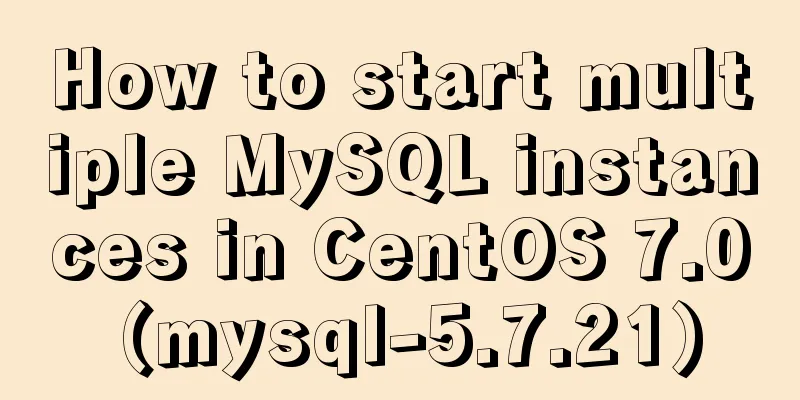How to start multiple MySQL instances in CentOS 7.0 (mysql-5.7.21)

|
Configuration Instructions Linux system: CentOS-7.0 MySQL version: 5.7.21 There are currently two known ways to start multiple MySQL instances under Linux. One is to use the official mysqld_multi.server, but I haven't studied how to do it yet. The other is to use the original method of installing multiple MySQL servers. I am currently using the second method. Successfully started two MySQL instances. Next, I will introduce the operation process. Please give me your advice. 1. Install the first MySQL (5.7.21) server First of all, I installed mysql using the binary package: mysql-5.7.21-linux-glibc2.12-x86_64.tar.gz 1. Get the MySQL binary package, then decompress it using the tar command. Rename the decompressed folder to a shorter name using the 2. After reading many MySQL installation method introductions on the Internet, they all mentioned adding new user groups and users: groupadd mysql and useradd -r -g mysql -s /bin/false mysql, adding mysql users and mysql user groups. This depends on your actual needs. Since I use it myself and there is no security issue, I did not add any new ones and used root directly. If you need to add new users and user groups, you can search for information online or see it in the official MySQL manual: https://dev.mysql.com/doc/refman/5.7/en/binary-installation.html 3. Create a new my.cnf or copy it from somewhere else. The main thing is to specify parameters such as basedir, datadir, port number and socket in the initialization file. The following figure is the content of my my.cnf. Please replace the relevant parameters according to your actual path and put it in the installation directory:
4. According to the installation steps of the official document, you also need to create a new mysql-files folder in the installation directory. I am not sure why you need to create this folder. Here is the content of the official document: "The mysql-files directory provides a convenient location to use as the value for the secure_file_priv system variable, which limits import and export operations to a specific directory." 5. Next, initialize mysql. First, create a new data folder under the installation directory, then enter the bin folder of the installation directory and execute the following command: 6. Next, create the certificate and key required for secure transmission. Execute the command in the bin directory: 7. At this point, the initialization of mysql is complete, and you can start the mysql server. After version 5.7, it seems that the service is started using the mysqld_safe command. You can also use mysql.server in the support-file directory to start it, but mysql.server is also started using mysqld_safe. The command of mysqld_safe is as follows: For detailed parameters of the mysql_safe command, please refer to: https://www.jb51.net/article/52259.htm 8. After starting the server, you can use the client to access the server. Execute the command in the bin directory: 9. At this point, the installation of mysql has been completed. 2. Install the nth MySQL (5.7.21) server With the above installation process, basically installing the nth MySQL is the same as above. Unzip the installation package, rename it to mysql_port, distinguish different MySQL servers by port number, and then replace the path parameters in my.cnf and the commands executed above with the corresponding paths. By specifying a specific path, you can install and start multiple MySQL instances on a Linux machine. When the client accesses the server, it needs to specify which port to use, using the parameter -P3306, with capital P. This is just a record and study of a simple installation process. There are still many configurations and functions of MySQL that need attention, and I will have the opportunity to sort them out later. Summarize The above is the full content of this article. I hope that the content of this article will have certain reference learning value for your study or work. If you have any questions, you can leave a message to communicate. Thank you for your support for 123WORDPRESS.COM. You may also be interested in:
|
<<: Complete steps to upgrade Nginx http to https
>>: Vue implements the requirement of dragging and dropping dynamically generated components
Recommend
Detailed explanation of the process of Zabbix active, passive and web monitoring in distributed monitoring system
In the previous article, we learned about the net...
About the implementation of JavaScript carousel
Today is another very practical case. Just hearin...
HTML version declaration DOCTYPE tag
When we open the source code of a regular website...
3 ways to correctly modify the maximum number of connections in MySQL
We all know that after the MySQL database is inst...
A brief discussion on the difference between Mysql primary key index and non-primary key index
Table of contents What is an index The difference...
Hidden overhead of Unix/Linux forks
Table of contents 1. The origin of fork 2. Early ...
Example of deploying MySQL on Docker
Table of contents 1 What is container cloud? 2 In...
Why is it slow when using limit and offset paging scenarios?
Let’s start with a question Five years ago when I...
Docker cross-server communication overlay solution (Part 1) Consul single instance
Table of contents Scenario Task idea analyze Conc...
Use and understanding of MySQL triggers
Table of contents 1. What is a trigger? 2. Create...
Introduction to Javascript DOM, nodes and element acquisition
Table of contents DOM node Element node: Text nod...
Implementation example of video player based on Vue
When the existing video player cannot meet the ne...
Build nginx virtual host based on domain name, port and IP
There are three types of virtual hosts supported ...
Do you know all 24 methods of JavaScript loop traversal?
Table of contents Preface 1. Array traversal meth...
Web Design Experience: Self-righteous Web Designers
1. Trash or Classic? Web technology updates very ...










